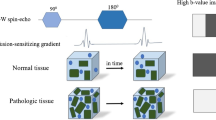Abstract
Functional magnetic resonance tomography provides a non-invasive method for mapping the cerebral cortex. The aim of the present work was to assess the potential and suitability of this method in a series of brain disorders. Studies were performed on 32 volunteers (mean age 37.8 ± 20.9 years) and 16 patients with tumors of the cerebral cortex (mean age 36.2 ± 24.2 years). Initial functional images were processed by statistical methods. Computed activation maps were superimposed on anatomical images. In 89% of cases, functional magnetic resonance tomography allowed the motor cortex and Broca's area to be localized; in almost 69%, the method impinged on the therapeutic tactics used in patients with cerebral cortex lesions. Thus, functional magnetic resonance tomography can be used in clinical conditions to obtain information not yielded by other diagnostic methods and which can be used to plan the neurosurgical treatment of patients with supratentorial brain tumors with maximum preservation of cerebral cortex function. Assessments of the state of the motor and speech areas by this tomographic method has potential applications in neurosurgery and neurophysiology.
Similar content being viewed by others
REFERENCES
O. V. Klimchuk and I. N. Pronin, “Mapping of the sensorimotor cortex of brain by functional magnetic resonance tomography in tumors of the frontal-parietal area,” Vopr. Neirokhir. N. N. Burdenko, 3, 21 (2000).
A. N. Konovalov, V. N. Korntsenko, and I. M. Pronin, Magnetic Resonance Tomography in Neurosurgery [in Russian], Vidar, Moscow (1997).
E. I. Chazov, “Twentieth-Century Medicine. The evolution of diagnostics,” in Ter. Arkhiv., 4, 19–21 (1995).
E. Achten, G. D. Jackson, J. A. Cameron, D. F. Abbott, D. L. Stella, and G. C. Fabinyi, “Presurgical evaluation of the motor hand area with functional MR imaging in patients with tumors and dysplastic lesions,” Radiology, 210, 529–538 (1999).
R. Beisteiner, R. Lanzenberger, K. Novak, V. Edward, C. Windischberger, M. Erdler, R. Cunnington, A. Gartus, B. Streibl, E. Moser, T. Czech, and L. Deecke, “Improvement of presurgical patient evaluation by generation of functional magnetic resonance risk maps,” Neurosci., 290, 13–16 (2000).
J. W. Belliveau, D. N. Kennedy, Jr., R. C. McKinstry, B. R. Buchbinder, R. M. Weisskoff, M. S. Cohen, J. M. Vevea, T. J. Brady, and B. R. Rosen, “Functional mapping of the human visual cortex by magnetic resonance imaging,” Science, 254, 716–719 (1991).
S. Y. Bookheimer, M. H. Strojwas, and M. S. Cohen, “Patterns of brain activation in people at risk for Alzheimer's disease,” New Engl. J. Med., 343,No. 7, 450–456 (2000).
G. A. Calvert, M. J. Brammer, R. G. Morris, S. C. Williams, N. King, and P. M. Matthews, “Using fMRI to study recovery from acquired dysphasia,” Brain Lang., 71, 391–399 (2000).
S. Dymarkowski, S. Sunaert, S. Van Oostende, P. Van Hecke, G. Wilms, P. Demaerel, B. Nuttin, C. Plets, and G. Marchal, “Functional MRI of the brain: localization of eloquent cortex in focal brain lesion therapy,” Eur. Radiol., 8, 1573–1580 (1998).
M. Essig, S. O. Schoenberg, H. P. Schlemmer, R. Metzner, and G. Van Kaick, “Radiologische Diagnostik und Nuklearmedizin. Funktionelle Magnetresonanztomographie in der Neuroradiologie,” Der Radiologie, 40,No. 10, 849–857 (2000).
A. S. Field, Yen Yi-Fen, J. H. Burdette, and A. D. Elster, “False cerebral activation on BOLD functional MR images: study of low-amplitude modulation weakly correlated to stimulus,” Amer. J. Neuroradiol., 21, 1388–1396 (2000).
J. A. Frank, J. L. Ostuni, Y. Yang, Y. Shiferaw, A. Patel, J. Qin, V. S. Mattay, B. K. Lewis, R. L. Levin, and J. H. Duyn, “Technical solution for an interactive functional MR imaging examination: application to a physiologic interview and the study of cerebral physiology,” Radiology, 210, 260–268 (1999).
D. Le Bihan, “Functional MRI of the brain: principles, applications and limitations,” J. Neuroradiol., 21, 1–5 (1996).
D. Le Bihan (ed.), Diffusion and Perfusion Magnetic Resonance Imaging: Applications to Functional MRI, Raven Press, New York (1995).
C. C. Lee, H. A. Ward, F. W. Sharbrough, F. B. Meyer, W. R. Marsh, C. Raffel, E. L. So, G. D. Cascino, C. Shin, Y. Xu, S. J. Riederer, and C. R. Jack, Jr., “Assessment of functional MR imaging in neurosurgical planning,” Amer. J. Neuroradiol., 20, 1511–1519 (1999).
N. E. Leeds and S. A. Kieffer, “Evolution of diagnostic neuroradiology from 1904 to 1999,” Radiology, 217, 309–318 (2000).
L. K. Masuoka, A. W. Anderson, J. C. Gore, G. McCarthy, D. D. Spencer, and E. J. Novotny, “Functional magnetic resonance imaging identifies abnormal visual cortical function in patients with occipital lobe epilepsy,” Epilepsia, 40,No. 9, 1248–1253 (1999).
Moller and B. Torsten, Pocket Atlas of Cross Sectional Anatomy: CT and MRI, Thieme, Stuttgart, New York (1994).
A. Mosso, Über den Kreislauf des Blutes im menschlichen Gehirn, von Veit, Leipzig (1881).
W. M. Mueller, F. Z. Yetkin, and T. A. Hammeke, “Functional magnetic resonance imaging mapping of the motor cortex in patients with cerebral tumors,” Neurosurgery, 39,No. 3, 515–521 (1996).
S. Ogawa, D. W. Tank, R. Menon, J. M. Ellermann, S. G. Kim, H. Merkle, and K. Ugurbil, “Intrinsic signal changes accompanying sensory stimulation — functional brain mapping with magnetic resonance imaging,” Proc. Natl. Acad. Sci. USA, 89, 5951–5955 (1992).
P. Pavone and P. Rossi (eds.), Syllabus Functional MRI, Springer, Milan (1996).
J. Pujol, J. Deus, and J. M. Losilla, “Cerebral lateralization of language in normal left-handed people studied by functional MRI,” Neurology, 52, 1038 (1999).
E. Schindler (ed.), Syllabus MR in Neuroradiology: Update and State of the Art, Centauro, Bologna (1999).
S. P. Springer and G. Deutsch, Left Brain, Right Brain, 2nd Edition Freeman, New York (1985).
K. R. Thulborn, J. C. Waterton, P. M. Matthews, and G. K. Radda, “Oxygenation dependence of the transverse relaxation time of water protons in whole blood at high field,” Biochem. Biophys. Acta, 714, 265–270 (1982).
Author information
Authors and Affiliations
Rights and permissions
About this article
Cite this article
Ternovoi, S.K., Sinitsyn, V.E., Evzikov, G.Y. et al. Localization of the Motor and Speech Zones of the Cerebral Cortex by Functional Magnetic Resonance Tomography. Neurosci Behav Physiol 34, 431–437 (2004). https://doi.org/10.1023/B:NEAB.0000022626.82165.d3
Issue Date:
DOI: https://doi.org/10.1023/B:NEAB.0000022626.82165.d3




